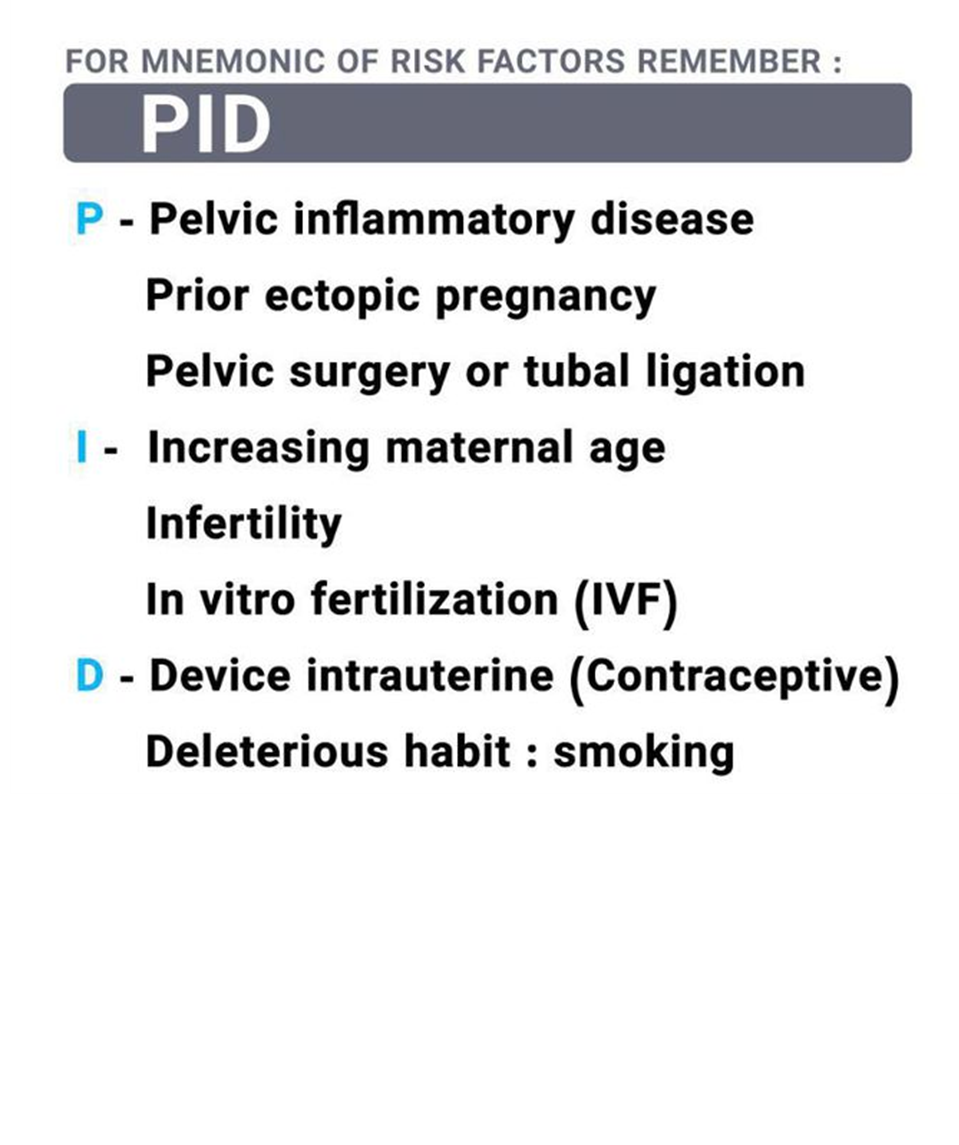A nurse is reviewing a client's history and physical examination findings. Which information would the nurse identify as contributing to the client's risk for an ectopic pregnancy?
recurrent pelvic infections
heavy, irregular menses
use of oral contraceptives for 5 years
ovarian cyst 2 years ago
The Correct Answer is A
A. Recurrent pelvic infections:
Pelvic infections, particularly those affecting the fallopian tubes (such as pelvic inflammatory disease), can lead to scarring and damage to the fallopian tubes. Scar tissue can obstruct the normal passage of the fertilized egg, increasing the risk of ectopic pregnancy.
B. Heavy, irregular menses:
While irregular menstrual cycles can sometimes be associated with conditions like polycystic ovary syndrome (PCOS), heavy and irregular menses are not typically considered direct risk factors for ectopic pregnancy. However, underlying conditions contributing to irregular menstrual cycles, such as hormonal imbalances or conditions affecting the reproductive organs, could potentially increase the risk.
C. Use of oral contraceptives for 5 years:
Oral contraceptives (birth control pills) are known to significantly reduce the risk of ectopic pregnancy. They work by preventing ovulation and altering the uterine lining, making it less likely for a fertilized egg to implant outside the uterus. Therefore, long-term use of oral contraceptives would generally decrease the risk of ectopic pregnancy rather than increase it.
D. Ovarian cyst 2 years ago:
While ovarian cysts are common and usually benign, they typically do not directly contribute to the risk of ectopic pregnancy. However, certain types of ovarian cysts, such as those associated with conditions like polycystic ovary syndrome (PCOS) or endometriosis, may indirectly affect fertility and increase the risk of complications during pregnancy, including ectopic pregnancy.

Nursing Test Bank
Naxlex Comprehensive Predictor Exams
Related Questions
Correct Answer is C
Explanation
A. Disseminated intravascular coagulation (DIC):
DIC is a serious condition characterized by abnormal clotting throughout the body's blood vessels, leading to both bleeding and clotting simultaneously. While it can occur in severe cases of HELLP syndrome, it is not a specific finding used to diagnose HELLP syndrome. Instead, it's a complication that can develop due to various underlying conditions, including HELLP syndrome.
B. Elevated platelet count:
In HELLP syndrome, platelet count is typically decreased, not elevated. HELLP syndrome stands for Hemolysis, Elevated Liver enzymes, and Low Platelets. The low platelet count is a key diagnostic feature of HELLP syndrome and contributes to the risk of bleeding complications.
C. Elevated liver enzymes:
Elevated liver enzymes, particularly elevated levels of AST (aspartate aminotransferase) and ALT (alanine aminotransferase), are hallmark features of HELLP syndrome. Liver involvement is a significant component of this syndrome, and elevated liver enzymes are part of the diagnostic criteria.
D. Hyperglycemia:
While hyperglycemia can occur in various conditions, it is not a characteristic finding of HELLP syndrome. HELLP syndrome primarily affects the liver, blood clotting factors, and platelets, leading to features such as elevated liver enzymes, low platelet count, and hemolysis (destruction of red blood cells).

Correct Answer is C
Explanation
A. 30 years:
The American Cancer Society does not recommend routine mammograms for women at average risk and with no family history of breast cancer starting at age 30. Mammograms at this age are generally not considered necessary unless there are specific risk factors or symptoms present that warrant earlier screening.
B. 35 years:
Similarly, the American Cancer Society does not recommend routine mammograms for women at average risk and with no family history of breast cancer starting at age 35. While early detection is important, routine screening mammography typically begins at a later age for women at average risk.
C. 45 years:
This is the correct choice according to the American Cancer Society's recommendations. For women at average risk and with no family history of breast cancer, the American Cancer Society suggests starting annual mammograms at age 45. This age was determined based on evidence indicating that screening mammography in this age group can effectively detect breast cancer and reduce mortality rates associated with the disease.
D. 40 years:
While some organizations, such as the American College of Radiology and the American College of Obstetricians and Gynecologists, recommend starting routine mammograms at age 40, the American Cancer Society suggests starting at age 45 for women at average risk and with no family history of breast cancer. The choice to begin screening at age 45 aligns with evidence-based recommendations and balances the benefits of early detection with the potential harms of false positives and overdiagnosis in younger women.
Whether you are a student looking to ace your exams or a practicing nurse seeking to enhance your expertise , our nursing education contents will empower you with the confidence and competence to make a difference in the lives of patients and become a respected leader in the healthcare field.
Visit Naxlex, invest in your future and unlock endless possibilities with our unparalleled nursing education contents today
Report Wrong Answer on the Current Question
Do you disagree with the answer? If yes, what is your expected answer? Explain.
Kindly be descriptive with the issue you are facing.
